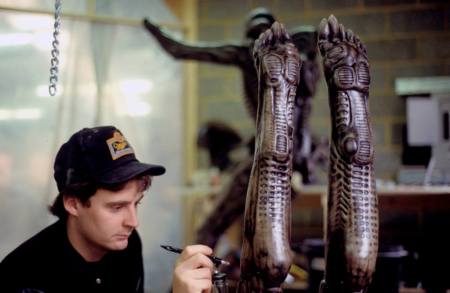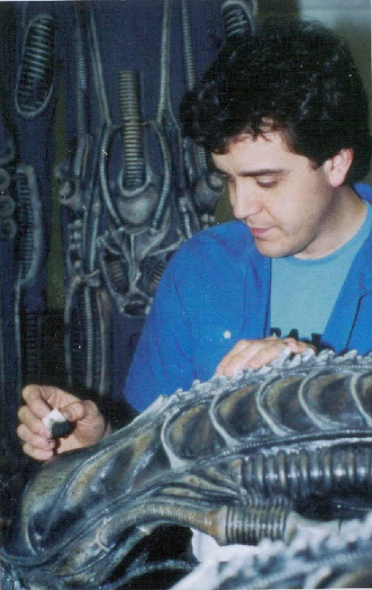Tom Woodruff Jnr. is a former member of Stan Winston Studios who collaborated in the making of Aliens and The Terminator. In 1989 he co-founded his own special effects company with Alec Gillis – Amalgamated Dynamics. His special effects work includes Tremors, Starship Troopers, Evolution, as well as Alien 3, Alien: Resurrection, and the two Alien vs. Predator films.
Tom has also portrayed a multitude of movie monsters, most famously the Alien creatures from the third, fourth and AvP movies.
Tom kindly agreed to an e-mail interview, and my friend Omega of Monster Legacy and I put our heads together to come up with some career-spanning questions for him.
Q: There’s a great photograph of you wearing the Alien suit from the second movie. Could you talk about how that came about and how (or if) your time in that suit factored into later decision making processes with Alien 3?
A: That was an after-hours thing that happened when the warrior suits were completed before filming started. Things get chaotic on set and long before digital cameras and cell phones, there wasn’t always a set photographer on hand to get beauty shots of the creatures before they get trashed during shooting. I suited up one night and we fired off a bunch of shots, without even the benefit of covering the suit in slime as intended for the film.
I was more interested in seeing how different body posing could disguise the shape of a man inside the suit than the intended on-screen finished look. But I wanted to be the man in the monster suit ever since I could remember watching monster movies on TV and after seeing some of the performances and physiques of some of the guys who ended up wearing the alien suits in Aliens, it motivated me to have a talk with Stan Winston that led to playing the Gill Man in Monster Squad in our very next film.
Q: The Alien in the third movie traded in many biomechanical details for a different aesthetic; you once said that you aimed for “an organic, sculptural feel.” Can you talk about what you tried to do to make this Alien look different from those that came before? (I believe you mentioned looking at Giger’s original paintings and drawings?)
A: I think people throw around the term “biomechanical” without really understanding what it means. It was a term manufactured to describe Giger’s amazing and fresh style of art. It was his theme in a lot of his work. What changed was the method in which it was achieved. During the build on Aliens, Fox provided us with many pieces of the original Alien creature suit and head. Within those pieces, you could actually see castings of mechanical bits; valves and plumbing pieces, some with catalogue numbers visible that had been etched into the pieces that were molded.
On Aliens, those pieces of the new suits evolved to be more organic and not just castings of off-the-shelf hardware. But the suits were still very broad in that they were sections glued to a spandex leotard with nothing more than slime-covered spandex to span the space between built-up sections.
On Alien 3, we took that to the next step and sculpted an entire body suit –not in an effort to make it look different– but to make it look more complete since the shooting style was going to be completely different and lighting would be revealing more of our single Alien than the hordes of the Cameron film. We relied heavily on images of Giger’s work from his own Necronomicon as the guide, seeking to replicate the organic life of that creature in more specific “Giger” detail than what was represented in the work of both Alien and Aliens.
Q: Michael Biehn relayed the story that during Alien 3’s production someone had spotted a bust of Hicks with the chest burst open. Was this ever planned to happen? (I assume the character’s head was pulverised due to Biehn’s objections to the scene.)
A: There was never a Hicks body with a chest burst open and it was never a story point in any of the material distributed to our crew. In the opening of Alien 3, we see the remains of Hicks with his head destroyed in the crash of the escape vehicle. That was done because we weren’t able to use Hicks’ likeness in the film.
Q: The corpses of Newt and Hicks were harrowingly realistic. Did pieces like these ever cause any sort of discomfort, or were you able to disassociate them from the actors and characters and see them purely as props?
A: Work like that becomes very clinical – artistic but clinical. It’s all about duplicating and creating recognizable features that sell the likeness. There is an element however in researching forensic photos in order to create a realism that was shocking although, over time, even that reaction becomes tempered.
Q: Everyone from Ridley Scott to Dan O’Bannon and James Cameron have said they were inspired by insects to create the life-cycles of their Aliens. In Alien Resurrection the ridged head of the Alien even resembles a cockroach shell – was this intentional? What did you look at when devising the Alien’s shape in the fourth movie?
A: It was never a pointed intention to duplicate a cockroach, but yes, the design element of the insect world is always prevalent in each design iteration. Changes brought about to the Alien from one film to the next have been at the design of the director, wanting to bring some new visual aspect to the creature. Part of our task had been to maintain what we could and make work for each new audience rather than reinvent the wheel.
Q: There was a rumour that ADI had pitched their own Alien 5 to Fox. If true, can you elaborate on your ideas?
A: If true, I would not elaborate.
Q: ADI has made an enormous array of creatures, from Graboids, to Aliens, to man-eating plants in Jumanji. Is there a kind of creature you always wanted to bring to the screen, but never had the chance to?
A: Every 6-8 months there is a new rumour that a remake of The Creature From the Black Lagoon is starting up. That’s what my radar is tracking although I think today it would be a huge battle to get anyone to consider a practical animatronic and costume approach, which is ironic because that’s exactly what made the originals so satisfying. The problem is that movies like that succeeded because they were “B Movies” and not meant to change your emotional center but just be a great way to spend two hours in a theatre. Today the choice would be made to turn it into a $140 million epic that relied on showing too much of the creature who would be a CGI element.
Q: Could you talk about the design of the Shriekers from Tremors 2: Aftershocks? What were they inspired by?
A: Very much inspired by the Graboid itself. The idea was to reverse-engineer the original creatures to establish the Shriekers as an earlier developmental stage, hence the translucent beak for example, as if it was still cartilage in development like a baby’s skull. The growth pattern would eventually have them begin to pack on pounds and become so huge and lethargic that their legs (which were only intended to carry them to a new location where food and protection would be more plentiful) would atrophy and fall off. They would then create a growth of spines that would propel them underground.
Q: What were the design inputs when conceiving the alien mutations in The Thing, especially in relation to Rob Bottin’s original work? (Was there a ‘Bottin style’ you adhered to?)
A: We designed the Thing creatures and effects, working with the director and producers. We had a lot of latitude in envisioning the look of the new creatures with variations as directed from above during the design and build. The goal was never to try to copy any particular Bottin creature but definitely to speak “in the same language”. That might be a pretty narrow line to imagine but a lot of that language was created in how the creatures were performed – live on set with the actors and sharing that environment. When you read about the creative freedom that Bottin held the biggest obstruction was not “what” the creatures were but “how” they would be articulated. Luckily, no one else knew how to do it and there wasn’t a big digital paintbrush waiting in post to taint his vision.
Q: The Pilot creature deleted from The Thing was undoubtedly a very unique monster. Could you talk about the design itself? What inspired it?
A: No one thing inspired the Pilot Creature, only that we wanted to be sure it looked like its own, stand-alone lifeform and not something that was already infected by The Thing – that was a crucial story point. So to that end, [it was] designed with a very biological symmetry, very specific eyes, and hands and feet that looked like they were nimble and with enough dexterity to pilot the ship.
Q: In 2014, ADI celebrates 25 years of effects making. What are your fondest memories from your experiences?
A: Looking back at the early years from this point in time is very nostalgic. For the most part, the artists and techs we’ve worked with from the very beginning are still around. But it’s harder and harder to find the work and the budgets that support the art so those early days were filled with more achievements. Even though we’re technically more savvy and have a lot better materials to work with, there is more work in convincing someone it can be done practically and not just as a digital post effect. And it’s been great to be able to meet the masters whose work inspired me to do what I do; John Chambers, Ray Harryhausen, Stan Winston, Rick Baker – It’s been a great 25 years.
Many thanks to Mr. Woodruff and the kind staff at Amalgamated Dynamics Inc.
Additional thanks to the salubrious Space Sweeper and a tip of the hat to Omega.





Great stuff. I check this blog regularly for updates. Keep up the good work.
That was awesome. Thanks for providing a great interview.
That was a great interview, I love reading about practical effects.
Great interview! Here are two links to a very interessting interview with founder of ADI, Alec Gillis.
This one is an edited version from the interview, which is great because they show a lot of stills and vid’s of ADI has done for movies the last years, but never got in to the final movies.
And here’s the complete Interview:
This is so very interesting to know about the Alien movies those involved done a lot of hard work I appreciate them. Especially Tom Woodruff Jr Signourney Weaver I will always love her since those films she is my true heroine
The lack of fine detail on the aliens after the first movie is disappointing. Aliens was ok, Alien 3 less so and Resurrection’s are outright terrible.